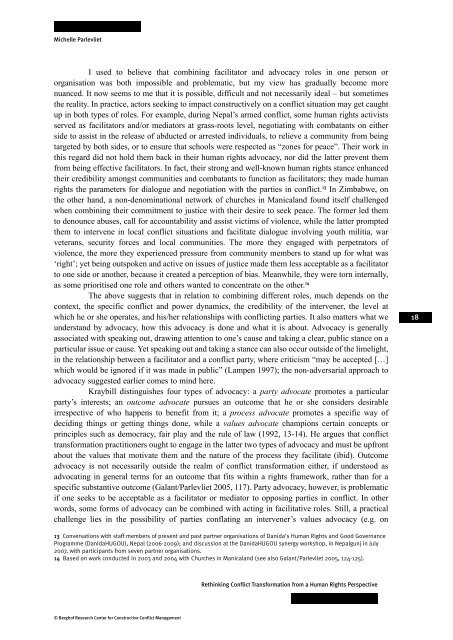Rethinking Conflict Transformation from a Human Rights Perspective
Rethinking Conflict Transformation from a Human Rights Perspective
Rethinking Conflict Transformation from a Human Rights Perspective
You also want an ePaper? Increase the reach of your titles
YUMPU automatically turns print PDFs into web optimized ePapers that Google loves.
Michelle Parlevliet<br />
I used to believe that combining facilitator and advocacy roles in one person or<br />
organisation was both impossible and problematic, but my view has gradually become more<br />
nuanced. It now seems to me that it is possible, difficult and not necessarily ideal – but sometimes<br />
the reality. In practice, actors seeking to impact constructively on a conflict situation may get caught<br />
up in both types of roles. For example, during Nepal’s armed conflict, some human rights activists<br />
served as facilitators and/or mediators at grass-roots level, negotiating with combatants on either<br />
side to assist in the release of abducted or arrested individuals, to relieve a community <strong>from</strong> being<br />
targeted by both sides, or to ensure that schools were respected as “zones for peace”. Their work in<br />
this regard did not hold them back in their human rights advocacy, nor did the latter prevent them<br />
<strong>from</strong> being effective facilitators. In fact, their strong and well-known human rights stance enhanced<br />
their credibility amongst communities and combatants to function as facilitators; they made human<br />
rights the parameters for dialogue and negotiation with the parties in conflict. 13 In Zimbabwe, on<br />
the other hand, a non-denominational network of churches in Manicaland found itself challenged<br />
when combining their commitment to justice with their desire to seek peace. The former led them<br />
to denounce abuses, call for accountability and assist victims of violence, while the latter prompted<br />
them to intervene in local conflict situations and facilitate dialogue involving youth militia, war<br />
veterans, security forces and local communities. The more they engaged with perpetrators of<br />
violence, the more they experienced pressure <strong>from</strong> community members to stand up for what was<br />
‘right’; yet being outspoken and active on issues of justice made them less acceptable as a facilitator<br />
to one side or another, because it created a perception of bias. Meanwhile, they were torn internally,<br />
as some prioritised one role and others wanted to concentrate on the other. 14<br />
The above suggests that in relation to combining different roles, much depends on the<br />
context, the specific conflict and power dynamics, the credibility of the intervener, the level at<br />
which he or she operates, and his/her relationships with conflicting parties. It also matters what we<br />
understand by advocacy, how this advocacy is done and what it is about. Advocacy is generally<br />
associated with speaking out, drawing attention to one’s cause and taking a clear, public stance on a<br />
particular issue or cause. Yet speaking out and taking a stance can also occur outside of the limelight,<br />
in the relationship between a facilitator and a conflict party, where criticism “may be accepted […]<br />
which would be ignored if it was made in public” (Lampen 1997); the non-adversarial approach to<br />
advocacy suggested earlier comes to mind here.<br />
Kraybill distinguishes four types of advocacy: a party advocate promotes a particular<br />
party’s interests; an outcome advocate pursues an outcome that he or she considers desirable<br />
irrespective of who happens to benefit <strong>from</strong> it; a process advocate promotes a specific way of<br />
deciding things or getting things done, while a values advocate champions certain concepts or<br />
principles such as democracy, fair play and the rule of law (1992, 13-14). He argues that conflict<br />
transformation practitioners ought to engage in the latter two types of advocacy and must be upfront<br />
about the values that motivate them and the nature of the process they facilitate (ibid). Outcome<br />
advocacy is not necessarily outside the realm of conflict transformation either, if understood as<br />
advocating in general terms for an outcome that fits within a rights framework, rather than for a<br />
specific substantive outcome (Galant/Parlevliet 2005, 117). Party advocacy, however, is problematic<br />
if one seeks to be acceptable as a facilitator or mediator to opposing parties in conflict. In other<br />
words, some forms of advocacy can be combined with acting in facilitative roles. Still, a practical<br />
challenge lies in the possibility of parties conflating an intervener’s values advocacy (e.g. on<br />
13 Conversations with staff members of present and past partner organisations of Danida’s <strong>Human</strong> <strong>Rights</strong> and Good Governance<br />
Programme (DanidaHUGOU), Nepal (2006-2009); and discussion at the DanidaHUGOU synergy workshop, in Nepalgunj in July<br />
2007, with participants <strong>from</strong> seven partner organisations.<br />
14 Based on work conducted in 2003 and 2004 with Churches in Manicaland (see also Galant/Parlevliet 2005, 124-125).<br />
© Berghof Research Center for Constructive <strong>Conflict</strong> Management<br />
<strong>Rethinking</strong> <strong>Conflict</strong> <strong>Transformation</strong> <strong>from</strong> a <strong>Human</strong> <strong>Rights</strong> <strong>Perspective</strong><br />
18
















